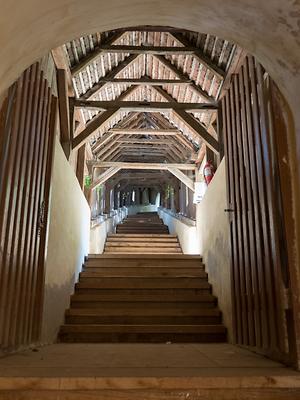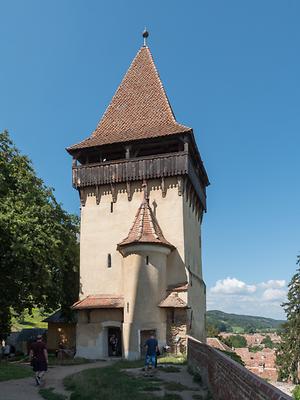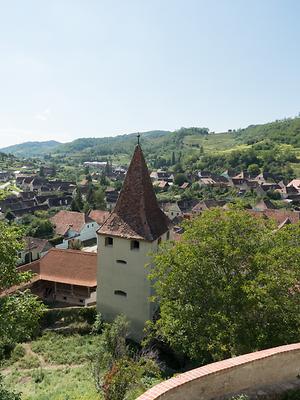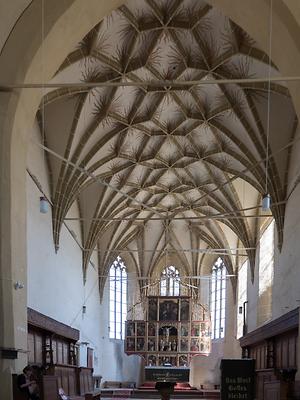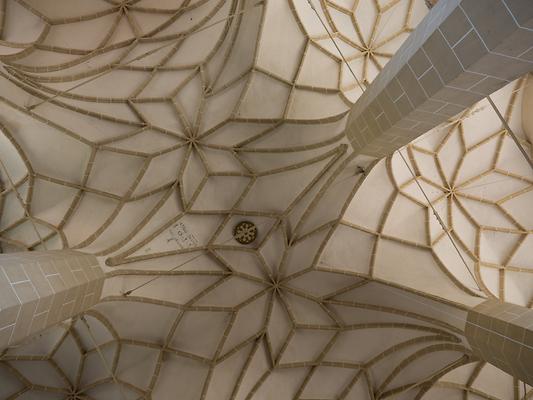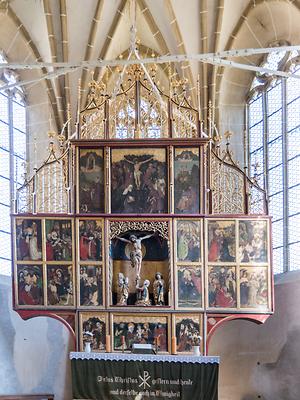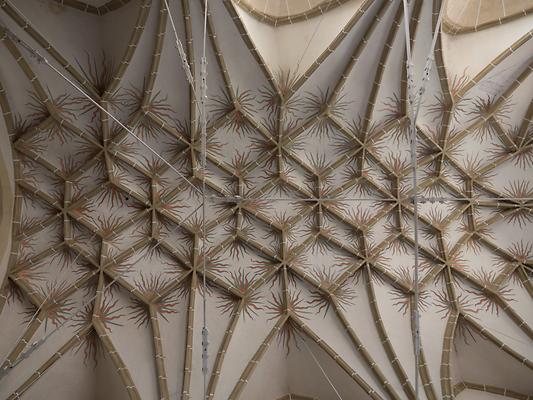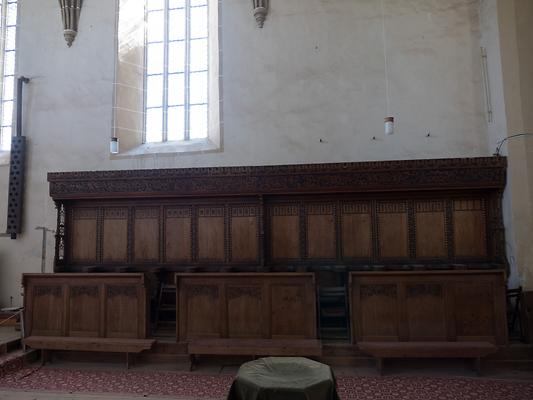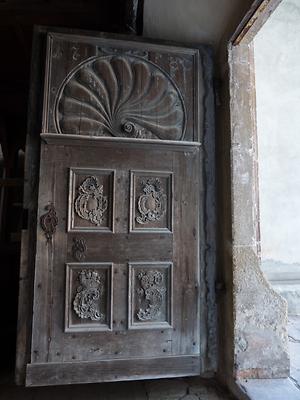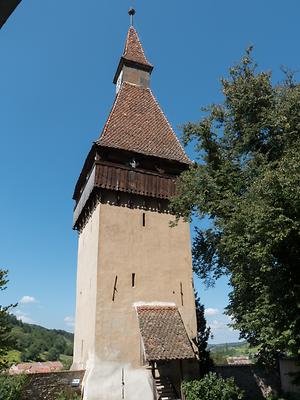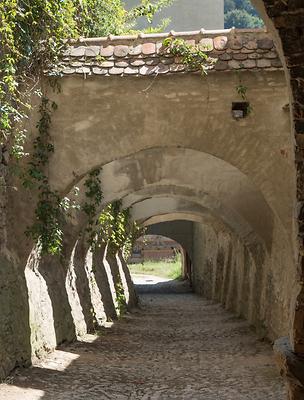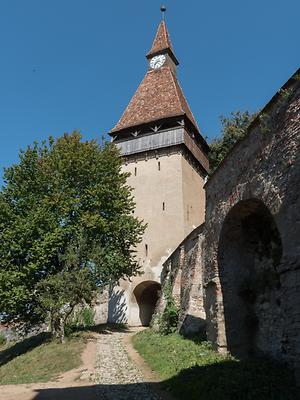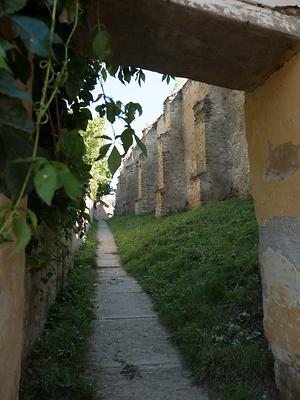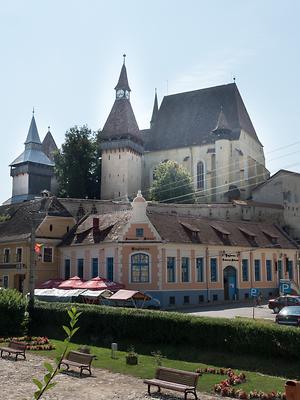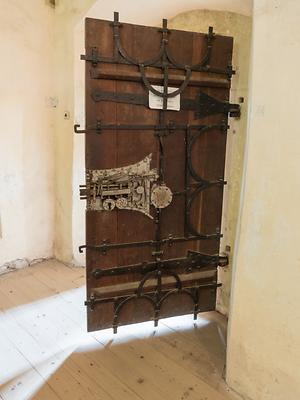Biertan (Birthäm)#
Der Ort Biertan Biertan, Rumänien liegt auf dem ehemaligen Königsboden [1] in einem Seitental der Târnava Mare (Große Kokel). Die Kreisstadt Sibiu (Hermannstadt) liegt 80 km in südwestliche Richtung.Die Gemeinde Biertan besteht aus den Dörfern Biertan, Richiș (Reichesdorf) und Copșa Mare (Groß-Kopisch) und hat etwa 2500 Einwohner.
Mehr zum Ort unter Biertan.
- Der folgende Text und alle Bilder sind © Heimo Müller, Sommer 2016
Birthälm, rumänisch Biertan, liegt in einem Seitental der großem Kockel (Târnava Mare). Der Ort hatte im 15. und 16. Jhd, überregionale Bedeutung und war nach der Wahl von Lucas Ungerus zum evangelischen Bischof von Siebenbürgen sogar für 295 Jahre Bischofssitz.
Die Kirchenburg, datiert auf Ende des 14. oder Anfang des 15. Jahrhunderts, erhebt sich auf einem steilen Hügel inmitten des Ortes. Als Bischofssitz wurde die Kirchenburg aufwendig ausgestattet. Die gotische Hallenkirche (ohne Turm) ist umgeben von drei Ringmauern, sechs Türmen mit Pyramidendach (Stundenturm, Glockenturm, Mausoleumsturm, Katholischer Turm, Speckturm, Einfahrtsturm), zwei Türmen mit Pultdach (Rathausturm, Weberturm) sowie von einer Bastei in der das Scheidungshaus bzw. Ehegefängnis untergebracht ist. 1993 wurde die Kirchenburg in das UNESCO-Weltkulturerbe aufgenommen.
The community of Biertan consists of the villages Biertan, Richiș (the former Reichesdorf) and Copșa Mare (the former Groß-Kopisch) and has about 2500 inhabitants.
More about Biertan.
- The following text and all pictures are © Heimo Müller, summer 2016.
Biertan, the former Birthälm, is located in a tributary valley of the Big Târnava (Târnava Mare). In the 15th and 16th century, the place was of supraregional significance, and after the election of Lucas Ungerus as evangelical bishop of Transylvania it even was a diocesan town for 295 years.
Die fortified church, dating back to the late 14th or early 15th century, stands on a steep hill in the middle of the village. As a bishop's see, the fortified church was expensively equipped. The Gothic hall church (without a tower) is surrounded by three circular walls, six towers with pyramidal broach roofs ('Clock Tower', 'Bell Tower', 'Mausoleum Tower', 'Catholic Tower', 'Bacon Tower', 'Gate Tower'), two towers with pent roofs (Town Hall Tower, 'Weaver's Tower') and a bastion housing a prison for married couples who wanted to get divorced because they could no longer live together in peace. In 1993 the church was listed as a UNESCO World Cultural Heritage.
[1] "Königsboden" ist ein alter Regionsname in Siebenbürgen und deutet auf die besondere Rechtslage des Gebiets im Mittelalter hin. Ab dem 12. Jahrhundert war das relativ dünn besiedelte Gebiet durch deutsche Siedler erschlossen worden und ein zusammenhängender königlicher Besitz; der ungarische König Géza II. warb ab 1146 Siedler aus dem Deutschen Reich an. Mittelalterliche Quellen nannten das Gebiet damals terra regis oder fundus regis. Die dort lebenden Siebenbürger Sachsen waren nur dem König von Ungarn untertan, der sie im Goldenen Freibrief von 1224 (Andreanum) mit weitreichenden Privilegien und Sonderrechten sowie einer Art Autonomiestatut ausstattete.
